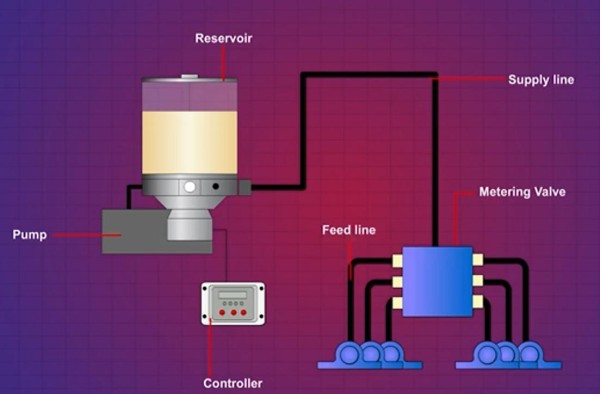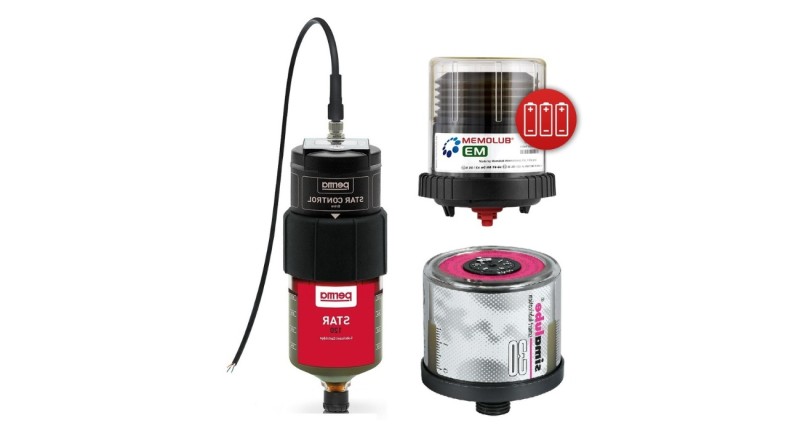An Automatic Lubricator is a device that automatically dispenses lubricants, such as oil or grease, onto machinery components. The device is programmed to release a lubricant at predetermined intervals, depending on the machine's needs, allowing for accurate and consistent lubrication of machinery components. The dispensing period can be selected according to each application’s requirements and can vary from hourly to daily, weekly, monthly, or yearly. Lubrication helps reduce friction, wear and tear, prolonging the machinery’s life and improving its performance.
Components of an Atomatic Lubricator:
- Reservoir: Where the lubricant is stored.
- Metering Valve: Measures and supplies the right amount of lubricant.
- Pump: Transports the lubricant from the reservoir to its destination.
- Supply Lines: Lines that connect the pump and the metering valve.
- Feed Lines: Lines that connect the metering valve and points of application. Feed lines are smaller in size than supply lines.
- Control System: Monitors the lubrication system and adjusts the flow of lubricant as needed.

The reservoir is filled with a lubricant connected to a timed-release valve. When the valve is triggered, a preset amount of oil/grease is released and applied to various moving parts of the machine, preventing the machinery from over-lubrication and under-lubrication. The reservoir may be refilled when the lubricant runs low, and may adjust the valve to release the lubricant more or less often, depending on the lubrication needs of the machine.
Advantages of An Automatic Lubricator
An automatic lubricator can help reduce costs associated with manual lubrication, reduce human error, improve safety, reduce downtime, and increase equipment life. Automatic lubrication systems can deliver the right amount of lubricant to each point of lubrication, at the right time and in the right quantities, which helps ensure equipment runs more efficiently and safely.
With automatic lubrication systems, the inaccessible parts of the machinery can be easily lubricated. Worker safety is another benefit of an automated lubricator, as it becomes unnecessary for technicians to manually apply lubricant while machinery is operating or in hazardous, difficult-to-reach locations. Automatic lubricators also prevent excess lubricant from reaching the finished product or other surfaces in the workplace, which decreases cleanup and disposal problems and less waste of lubricant.
In addition, an automated lubrication system significantly increases the life span of machine parts. The average serviceable life of a manually lubricated roller chain is about six to eight months. However, the serviceable life of roller chains increases to twelve to eighteen months when using an automatic lubricator. Bearings are also prone to premature failure from poor lubrication. Most of the bearing failures happen either from a lack of lubrication or contamination. Proper lubrication and a contaminant-free environment can extend a bearing’s life span by multiple times.
Most often, before manual lubrication, lubrication points are not properly cleaned. Contaminants such as chemicals or sand enter the lubrication point. With automatic lubrication, the grease is pumped through a filter before it enters the lubricator's reservoir, limiting contaminants' penetration into these lubrication points.
Proper lubrication requires an extremely thin layer of lubricant separating the moving surfaces. For grease applications, the volume of grease required is equal to an average thickness of 0.001 inches (1/1000 inch) of the surface area, applied every four hours. It’s a simple task for an automated lubrication system; however, it is nearly impossible to achieve the results manually.
Feel free to visit HVH Industrial Solutions if you have any questions, need more information, or are interested in purchasing an automatic lubricator.
Also, you can check our Engineering Blog for more informative articles.
Also Check: Explain Gambling and its types?

